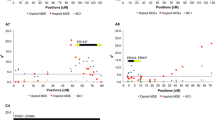Summary
The inheritance of the low linolenic acid content (derivated from mutant lines) in rapeseed was investigated. Molecular techniques of gene mapping through RAPD markers were applied on a microspore-derived progeny from a high × low linolenic acid F1 hybrid. ‘Bulked segregant analysis’ made it possible to test rapidly number of RAPD primers. Two linkage groups of 6 markers (72.7 cM and 75.6 cM) were determined. Each corresponded to a major QTL which explained 24% and 30.7% of the total phenotypic variation of the linolenic acid content. It was confirmed that two independant mutations were implied in the low linonenic acid content.
Similar content being viewed by others
References
Arondel V., B. Lemieux, I. Hwang, S. Gibson, H.M. Goodman & C.R. Somerville, 1992. Map-based cloning of a gene controlling omega-3 fatty acid desaturation in Arabidopsis. Science 258: 1353–1354.
Brunklaus-Jung E. & G. Röbbelen, 1987. Genetical and physiological investigations on mutants for polyenoic fatty acids in rapeseed (Brassica napus L.) Plant Breeding 98: 9–16.
Chen J.L. & W.D. Beversdorf, 1990. A comparison of traditional and haploid-derived breeding populations of oilseed rape (Brassica napus L.) for fatty acid composition of the seed oil. Euphytica 51: 59–65.
Doyle J.J. & J.L. Doyle, 1990. Isolation of plant DNA from fresh tissues. Focus 12: 13–15.
Ferreira M.E., P.H. Williams & T.C. Osborn, 1994. RFLP mapping of Brassica napus using doubled haploid lines. Theor Appl Genet 89: 615–621.
Foisset N., R. Delourme, M.O. Lucas & M. Renard, 1993. Segregation analysis of isozyme markers on isolated microspore-derived embryos in Brassica napus L. Plant Breeding 110: 315–322.
Foisset N. & R. Delourme, 1995. Segregation distortion in androgenic plants. In: S. Jain Mohan, S.K. Sopory & R.E. Veilleux (Eds.), In Vitro Haploid Production in Higher Plants. Kluwer Academic Publishers. Dordrecht, The Netherlands, in review.
Fossati P., 1994. Les huiles de poisson: actualités scientifiques et médicales. OCL 1(3): 178–180.
Haley S.D., L. Afanador & J.D. Kelly, 1994. Selection for monogenic pest resistance traits with coupling- and repulsion-phase RAPD markers. Cell Biology and Molecular Genetics. Crop Sci 34: 1061–1066.
Harvey B.L. & R.K. Downey, 1963. The inheritance of erucic acid content in rapeseed (Brassica napus L.). Can J Plant Sci 44: 104–111.
Harwood J.L. 1994. Environmental effects on plant lipid metabolism. INFORM 5: 835–839.
Hu J., J.H. Quiros, P. Arus, D. Struss & G. Robbelen, 1994. Tagging of a gene determining linolenic acid concentration in rapeseed with DNA-based markers. Cruci Newsl 16: 42–43.
Jönsson R. & C. Persson, 1983. Breeding for improved fatty acid composition in rapeseed. Proc 6th Int Rapeseed Conf, Paris, France 1: 311–314.
Jourdren, C., P. Barret, D. Brunel, R. Debourne & M. Renard, 1996. Specific molecular marker of the genes controlling line acid content in rapeseed. Theor Appl Genet (in press).
Lander E.S., P. Green, J. Abrahamson, A. Barlow, M.J. Daly, S.E. Lincoln & L. Newburg, 1987. MAPMAKER: an interactive computer package for constructing primary genetic linkage maps of experimental and natural populations. Genomics 1: 174–181.
Martin G.B., J.G.K. Williams & S.D. Tanksley, 1991. Rapid identification of markers linked to a Pseudomonas resistance gene in Tomato by using random primers and near-isogenic lines. Proc Natl Acad Sci USA 88: 2336–2340.
Melchinger A.E., 1990. Use of molecular markers in breeding for oligogenic disease resistance. Plant Breeding 104: 1–9.
Michelmore R.W., I. Paran & R.V. Kesseli, 1991. Identification of markers linked to disease-resistance genes by bulked segregant analysis: a rapid method to detect markers in specific genomic regions by using segregating populations. Proc Natl Acad Sci 88: 9828–9832.
Miquel F.M. & J.A. Browse, 1994. High-oleate oilseeds fail to develop at low temperature. Plant Physiol 106: 421–427.
Morice J., 1979. Les nouvelles varietés de colza. In: Symposium April 1978, Bruxelles. Expose 4, 22 p. Commission Commun Europe, Luxembourg.
Pleines S. & W. Friedt, 1989. Genetic control of linolenic acid concentration in seed oil of rapeseed (B. napus L.). Theor Appl Genet. 78: 793–797.
Polsoni L., L.S. Kott & W.D. Beversdorf, 1988. Large scale microspore culture technique for mutation-selection studies in Brassica napus. Can J Bot 66: 1681–1685.
Powell W., W.T.B. Thomas, D.M. Thompson, J.S. Swanston & R. Waugh, 1992. Association between rDNA alleles and quantitative traits in doubled haploid populations of barley. Genetics 130: 187–194.
Röbbelen G. & A. Nitsch, 1975. Genetical and physiological investigations on mutants for polyenoic fatty acids in rapeseed (B. napus L.) I. Selection and description of new mutants. Z Pflanzenzüchtg 75: 93–105.
SAS Institute Inc., 1988. SAS Users Guide: Statistics. SAS Institute Cary, N.C.
Scarth R., P.B.E. Mcvetty, S.R. Rimmer, & B.R. Stefansson, 1991. Hero summer rape. Can J Plant Sci 71: 865–866.
Scarth R., P.B.E. Mcvetty & B.R. Stefansson, 1988. Stellar low linolenic-high linoleic acid summer rape. Can J Plant Sci 68: 509–511.
Tanhuanpää P.K., J.P. Vilkki & K.J. Vilkki 1995. Association of a RAPD marker with linolenic acid concentration in the seed oil of rapeseed (Brassica napus L.). Genome 38: 414–416.
Thies W., 1971. Schnelle und Einfache Analysen der Fettsäurezusammensetzung in Einzelnen Rapskotyledonen. I. Gaschromatographische und papier-Chromatographische Methoden. Z Pflanzenzüchtg 65: 181–202.
Williams J.G.K., A.R. Kubelik, K.J. Livak, J.A. Rafalski & S.V. Tingey, 1990. DNA polymorphism and amplified by arbitrary primers are useful as genetic markers. Nucleic Acids Res 18: 6531–6535.
Yadav N.S., A. Wierzbicki, M. Aegerter, C.S. Caster, L. Pérez-Grau, A.J. Kinney, W.D. Hitz, J. Russel BoothJr, B. Schweiger, K.L. Stecca, S.M. Allen, M. Blackwell, R.S. Reiter, T.J. Carlson, S.H. Russel, K.A. Feldmann, J. Pierce & J. Browse, 1993. Cloning of higher plant ω-3 fatty acid desaturases. Plant Physiol 103: 467–476.
Young N.D., D. Zamir, M.W. Ganal & S.D. Tanksley, 1988. Use of isogenic lines and simultaneous probing to identify DNA markers tightly linked to the Tm-2a gene in Tomato. Genetic 20: 579–585.
Author information
Authors and Affiliations
Rights and permissions
About this article
Cite this article
Jourdren, C., Barret, P., Horvais, R. et al. Identification of RAPD markers linked to linolenic acid genes in rapessed. Euphytica 90, 351–357 (1996). https://doi.org/10.1007/BF00027487
Received:
Accepted:
Issue Date:
DOI: https://doi.org/10.1007/BF00027487



